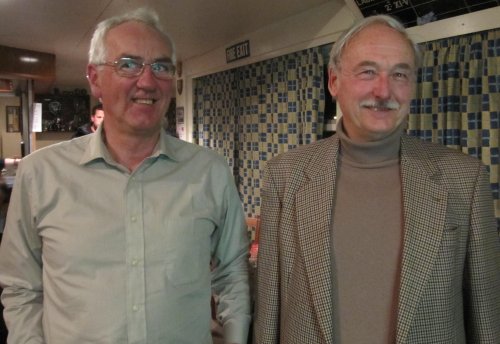

The weather is a bit warmer and in the orchards pruning is still the main task.
Last night The English Apple Man attended a BEST Group meeting titled The Answer Lies in the Soil!
Now I am sure we are all familar with the term, 'The Singer not The Song' used to describe how an eloquent speaker can vastly improve an ordinary story, well Robert Plumb is without doubt an eloquent speaker and uses his 'oratory' skills superbly, however the 'song' last night was also of superb quality, resulting in an absobing evening with so much valuable information revealed and debated.
 Soil Gurus, Robert Plumb and Simon van der Slikke, reviewed the key components essential to healthy root zones for high tree performance. Robert addressed 'soil fertility', and Simon illustrated 'how this helps protect your trees'
Soil Gurus, Robert Plumb and Simon van der Slikke, reviewed the key components essential to healthy root zones for high tree performance. Robert addressed 'soil fertility', and Simon illustrated 'how this helps protect your trees'
With pressure on our farmers and growers to increase home grown food production and reduce the high dependence on imports, soil 'fertility' and 'sustainability' are vital. Pressures on water supplies can be reduced with optimum soil management.
With two speakers disseminating so much information, it is impossible to do justice to their subject in one week's publication. However I will at the very least try to capture the salient points and allow my readers the opportunity to research further by visiting the websites of the creators of advanced soil management.
Robert Plumb - Independent Soils Services.
Robert recounted his journey from a fertilizer salesman to an expert on Biological Farming Solutions. He asked the question; Soil Fertility, what is it?
Soil is the most important asset on your farm!
Robert used the analogy of house building; you are building your soil, and Calcium = the sand, while Magnesium = the cement. Just as in house building, get the mix too sandy and the mortar will fall apart, get it too high in cement and it will develop cracks. Soil is the same and the Calcium v Magnesium balance is critical. So if their is an imbalance of the soil, with too much Calcium, the nutrients will leech from the soil and if the Magnesium is to high the soil will lock up the nutrients, starving the roots of access to life giving nutrients.
Robert spent time in Australia studying how bio-logical solutions can revitalise soils which have lost their natural fertility. There biological stimulants overcame the problems and crops grew with no fertilizer inputs. 'Year on Year' the soil analysis showed the available nutrients were going up, not down.
 Robert then studied the work of Neil Kinsey in the USA who used the 'Albrecht' principals developed by Dr. William Albrecht, who was Chairman of the Department of Soils at the University of Missouri, and the foremost authority on the relation of soil fertility to human health.
Robert then studied the work of Neil Kinsey in the USA who used the 'Albrecht' principals developed by Dr. William Albrecht, who was Chairman of the Department of Soils at the University of Missouri, and the foremost authority on the relation of soil fertility to human health.
The basis of Albrecht's belief is the soil must be well balanced with ALL nutrients available to the plant, not just headline elements like Nitrogen (N) Phosphate (P) and Potassium (K) but also all the trace elements. High on the list of importance is Boron, 'the driver' for Calcium uptake. Organic matter is critical to the sustainability of our soil mechanisms and healthy food with all the micro nutrients vital for our well being can only be found in food which is produced by plants growing in balanced soil.
A quote from Dr. Albrecht;
"Organic matter may well be considered as fuel for bacterial fires in the soil, which operates as a factory producing plant nutrients. The organic matter is burned to carbon dioxide, ash, and other residues. This provides carbonic acid in the soil water, and the solvent effect of this acidified water on calcium, potassium, magnesium, phosphates, and other minerals in rock form is many hundreds of times greater than that of rain water. At the same time the complex constituents of the organic matter are simplified, and nitrogen in the ammonia is released and converted into the nitrate form. This, very briefly, is the complicated process of decomposition, from which carbon dioxide results as the major simplified end product, together with a host of others in smaller amounts. This gas is released in such large quantities from the soil that the supply in the atmosphere over the earth is maintained at a constant amount".
Robert illustrated the importance of nutritional food by pointing out that on his visits to America it is clear very many Americans are overweight and unhealthy. Not surprising he said; their diet is ???? (a well known expression in the USA for rubbish) the diet is so lacking in nutrition that the food intake from a normal portion does not bring satisfaction, the result, hunger drives eating more and more of this nutritionally inadequate food and 'piles on the pounds'
Robert pointed out that farmers & growers have historically taken soil samples on a 3 year rotation and used the analysis to balance the soil with chemical fertilizers. PH (Power of Hydrogen) is used to determine the Calcium levels in the soil, and lime applied to restore/maintain the correct calcium levels in the soil; '6.5 - 7' is the ideal level for 'most, but not all' crops. However this is not an accurate system, it is very much a 'stab in the dark' approach, delivering a result of that small sample at 'one moment' in time!
PH is NOT an accurate measure of soil calcium levels and thousands of tonnes of lime have been 'historically' applied to farmland based on this 'broad brush' approach. PH is also influenced by rainfall and temperature. A dry summer will deliver a lower PH analysis. In addition lime does not have a constant calcium percentage, depending on where it is mined will influence its calcium content. Robert illustrated how Hereford Limestone when analysed, contained just 2 kilograms of calcium per tonne. Useful only for road making, not as an application for calcium deficiency.
The more detailed system of soil, leaf and product analysis (apples for instance) delivers a much more comprehensive picture. This is essential for the well being of the soil and an essential tool in the management and accurate use of fertilizers.
Robert emphasised the importance of the Calcium v Magnesium balance,
Capacity of the soil to hold nutrients is determined by the amount of clay and humus contained in the soil, these are the only parts of any soil that will attract and hold plant nutrients. Once this nutrient-holding capacity is reached, using more of any material containing the element that is already at optimum level will only result in driving off or tying up some other nutrient that should be there and available for use by plants growing in that soil.
So the nutrient balance necessary for producing optimum yields of nutritious food depends on many factors, beyond throwing N, P & K at the soil based on inaccurate analyses. The importance of Bacteria to the well being of the soil is paramount. Bacteria are able to perform an extremely wide range of chemical transformations, including degradation of organic matter, disease suppression, and nutrient transformations inside roots. Reduction of Bacteria in plant roots causes nitrogen fixation.
Simon van der Slikke
Simon is an old friend of The English Apple Man; in the 1980's Simon was my agronomy advisor.
Simon followed Robert's in depth analysis of 'all things soil' with a reminder of how Top Fruit growers can benefit from a well balanced soil.
A well balanced Soil will deliver better yields of quality fruit, storage life will be enhanced by the optimum nutritional balance in the fruit, and pest & disease control will be improved as a healthy plant/tree will be more resistant to mildew and more able to withstand the attacks of pests.
Simon illustrated how he manages orchard performance with an Integrated Crop Management (ICM) Action Plan.
What needs to be done?
Look after the soil structure; look for pans; 'subsoiling' may be necessary to break up a pan and allow oxygen to access all the soil. Avoiding excessive cultivation prior to planting. Introduce organic matter. Apply a mulch. Spray molasses. Sow a green winter cover. Check PH & tissue analysis; leaf & fruit.
Keep records of all analyses!
Simon related how on many occasions he has asked for records of previous soil analysis, and the grower has no clear system for holding this 'critical' information on file. "No info, No hope"
Use ammonium sulphate (not nitrates) slow release fertiliser is much better and apply in early spring time. This will improve fruiting and reduce tree vigour. Slow release Phosphate. Low Potash will increase mildew incidence. Use pottasium sulphate. Ammonia and Calcium fertiliser improve potash availability.
Foliar nutrients are a 'primer' to pump nutrients from the soil into the tree. Spray these between 3am and 10am avoiding the heat of the day. There is no nutrient uptake by the tree when sprayed in hot conditions.
Mycorrhizas.
This would fill a day on its own. Mycorrhiza fungi are vital in enabling the roots of a tree/plant to fully exploit the nutrients in the soil. It is now becoming commonplace for growers to introduce Mycorrhizas to the soil around the tree roots when planting.
"Mycorrhizae are very common but largely unseen symbioses between plant roots and fungi that are important in plant nutrition, community structure, and nutrient cycling. Throughout the course of their evolution, plants and fungi have formed many different types of mycorrhizal partnerships involving most plant families and thousands of fungal species"
In practical terms the mycorrhiza find their way into the tiny root fissures enabling maximum nutrient uptake by the tree..
AND, Earth Worms; both Simon and Robert extolled the value of earth worm activity. They improve water filtration rates and absorption rates, helping the soil to drain better, delivering improved water efficiency. Their tunnelling activity improves soil aeration, porosity and permeability. Worm castings have the ability to absorb moisture from the air and hold it in a manner that plants can use.
25 earthworms per square foot of soil is equal to one million per acre. Studies in England have shown that in healthy soil forty tonnes of worm castings per acre pass through earthworm bodies daily!
A study in European orchards found that earthworms could increase the pore space in soil by 75 - 100% and that earthworm burrows accounted for 50% of soils air-filled pores.
WHEW!
I think that is enough soil data for this week; the EAM's old brain is boiling over!
Essentially; the management of ALL factors involved in maintaining a well balanced soil is the key to regular cropping of high quality nutritious food. There are no short cuts if we are to deliver sustainable soil for our future generations.
That is all for this week.
Take care
The English Apple Man